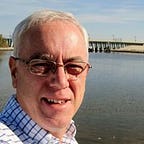Map-making Before GPS— François Perrier
At the end of the 19th century, François Perrier took the ancient art of map-making and geodetic science to a new level. Perrier received a rigorous education in science and mathematics at the Ecole Polytechnique, and he served his entire career as an officer in the French army. At the beginning of his career, Perrier worked on a project to connect the geodetic maps of France and England across the English Channel at Calais. In the world before satellites and GPS, maps were created by triangulation, that is by making painstaking measurements of angles and distances on the ground, and then performing highly detailed mathematical calculations, lot’s of calculations, by hand.
From his work performing triangulation across the English Channel Perrier came to the realization that map-makers in France, particularly those in the army, lagged behind other countries in knowledge and technology for measuring the Earth. France had been at the forefront of geodetic science at the beginning of the century, when Joseph Delambre and François Arago conducted geodetic surveys of the Paris Meridian from Dunkirk into Spain . This work formed the basis for establishing the length of the metre in the new Système International, the metric system. Perrier determined that he would devote his career to reversing the decline in geodesy in France.
Accurate measurement of the Earth had been a priority for French science since the establishment of Academy of Science in the 17th century. At first, the interest was in accurately mapping the national boundaries of France. Precise measurements to map locations and determine distances become increasingly important with the establishment of wide-ranging transportation and communication networks during the industrial revolution. Today, of course, we carry cell phones capable of determining our exact location anywhere on the Earth to within a couple of meters using GPS (geographic positioning system) technology .
However, Perrier faced a difficult task. At the end of the 19th century, the French army served as a bulwark of political conservatism, which valued the long-lived traditions at the core of national identity over progress and innovation. Perrier was widely recognized for his success in negotiating this treacherous political terrain, more so than for lasting importance of his contributions in either area of geodesy or military mapping. Under Perrier’s leadership as director of the army’s geographical service, geodetic research emerged as a center of technological excellence within the army, providing a mechanism for progressive reform in an organization that in many ways resisted the increasing influence of science and technology.
The mapping of Algeria stands a notable technical achievement in Perrier’s career. This task required years of effort working under difficult conditions imposed by a harsh climate, disease, and a hostile political situation. During the 19th century and the first half of the 20th century, Algeria was a colony chaffing under foreign rule by France. Working in collaboration with the Spanish geodetic survey, Perrier was able to join his geodetic network in Algeria, across the Mediterranean Sea, to an extension of the Paris Meridian survey south into Spain. This feat required making visual sightings between mountain peaks across more than 300 kilometres of open sea. To do this, Perrier installed powerful electric beacons on the mountain tops, each with its own electric generator and a steam engine to drive it.
François Perrier is one of the 72 scientists and engineers named on the Eiffel Tower.
